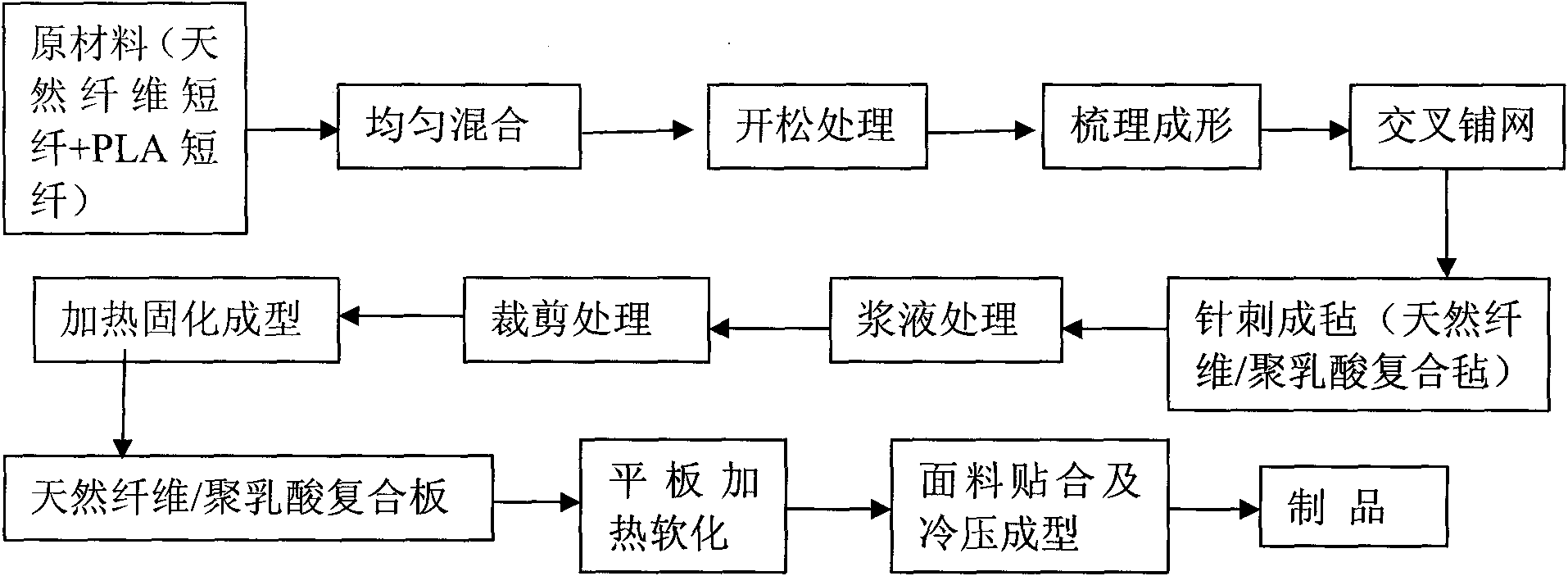Composite material for automobile interior part and production method thereof
A technology of automotive interior parts and composite materials
- Summary
- Abstract
- Description
- Claims
- Application Information
AI Technical Summary
Problems solved by technology
Method used
Image
Examples
Embodiment 1
[0035] Weigh the raw material (kg) according to the following weight:
[0036] Polylactic acid fiber 40, jute fiber 60;
[0037] Methods of producing automotive interior composites:
[0038] (1) the jute fiber of 7-15cm and 40 kilograms of 8-12cm polylactic acid fiber are evenly mixed by 60 kilograms of length;
[0039] (2) Put the mixed fiber into the opener to open and mix, mix for 30s, and then send it into the cotton box;
[0040] (3) The loosened and mixed fibers stored in the cotton box are transported to the carding machine by airflow for carding;
[0041] (4) The fiber after carding is sent to cross-lapping in the web-laying machine;
[0042] (5) After the laid net is folded according to the required requirements, it is sent into the pre-needling machine for pre-needling into felt;
[0043] (6) Send the pre-needled mat to the main needling machine for main needling. After reaching the predetermined gram weight, heat and pre-press it into a coil. The heating tempera...
Embodiment 2
[0048] Weigh the raw material (kg) according to the following weight:
[0049] Polylactic acid fiber 50, hemp fiber 30, flax 20;
[0050] Methods of producing automotive interior composites:
[0051] (1) 30 kilograms of length are the hemp fiber of 7-15cm, the flax fiber of 20 kilograms of length 7-15cm and 50 kilograms of 8-12cm polylactic acid fiber are evenly mixed;
[0052] (2) Put the mixed fiber into the opener to open and mix, mix for 40s, and then send it into the cotton box;
[0053] (3) Transport the loosened and mixed fibers stored in the cotton box to the carding machine for carding;
[0054] (4) The fiber after carding is sent to cross-lapping in the web-laying machine;
[0055] (5) Fold the laid net and send it into the pre-needling machine for pre-needling into felt;
[0056] (6) Send the pre-needled mat to the main needling machine for main needling. After reaching the predetermined gram weight, heat and pre-press it into a coil. The heating temperature is ...
Embodiment 3
[0059] Weigh the raw material (kg) according to the following weight:
[0060] Polylactic acid fiber 60, ramie fiber 20, sisal fiber 10, kenaf fiber 10;
[0061] Methods of producing automotive interior composites:
[0062] (1) the ramie fiber of 7-15cm, the sisal fiber of 7-15cm, the kenaf fiber of 7-15cm and the polylactic acid fiber of 60 kilograms of 8-12cm are evenly mixed in 10 kilograms of lengths by 20 kilograms of lengths;
[0063] (2) Put the mixed fiber into the opener to open and mix, mix for 20s, and then send it into the cotton box;
[0064] (3) The loosened and mixed fibers stored in the cotton box are transported to the carding machine by airflow for carding;
[0065] (4) The fiber after carding is sent to cross-lapping in the web-laying machine;
[0066] (5) After the laid net is folded according to the required requirements, it is sent into the pre-needling machine for pre-needling into felt;
[0067] (6) Send the pre-needled mat to the main needling mach...
PUM
| Property | Measurement | Unit |
|---|---|---|
| Length | aaaaa | aaaaa |
Abstract
Description
Claims
Application Information
 Login to View More
Login to View More - R&D
- Intellectual Property
- Life Sciences
- Materials
- Tech Scout
- Unparalleled Data Quality
- Higher Quality Content
- 60% Fewer Hallucinations
Browse by: Latest US Patents, China's latest patents, Technical Efficacy Thesaurus, Application Domain, Technology Topic, Popular Technical Reports.
© 2025 PatSnap. All rights reserved.Legal|Privacy policy|Modern Slavery Act Transparency Statement|Sitemap|About US| Contact US: help@patsnap.com



